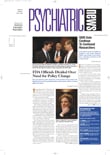A year ago APA Medical Director James H. Scully Jr., M.D., announced the creation of the Division of Advocacy. The move, he said, was to sharpen the focus of three APA offices and departments—Government Relations, Communications and Public Affairs, and Healthcare Systems and Financing—as well as to strengthen our ability to advocate on behalf of APA members, patients, and the profession.
A year later, Dr. Scully's vision is closer to being realized: our team is strong and well integrated. Working on major public policy issues and projects—the new Medicare Part D prescription drug benefit, the federal budget, and psychologist prescribing, to name a few—has helped to meld our team into a cohesive unit, too.
Today the advocacy team is fully staffed and is led by these individuals:
•
Nicholas Meyers, director of Government Relations, who was promoted to that post when the division was established,
•
Irvin “Sam” Muszynski, J.D., who has served as director of Healthcare Systems and Financing for many years,
•
Lydia Sermons-Ward, director of Communications and Public Affairs, who joined APA in June 2004,
•
And me, Eugene Cassel, J.D., division director and special counsel.
APA members routinely identify advocating for patients and the profession as their top priority. We are passionate about this work, and today at APA we do it in a more synchronized way. But there's more to our unity as a division than that: we strive to amplify APA's legislative and regulatory efforts, psychiatric-practice and business initiatives, and media and public affairs work. Let me give some recent examples.
The Department of Government Relations has worked tirelessly to inform Congress and the Food and Drug Administration that antidepressants save the lives of children and adolescents. Building on that effort, the Office of Communications and Public Affairs joined with the Division of Research to launch ParentsMedGuide.org (Psychiatric News, March 4).
The February press conference to publicize the new site caught the public's attention—earning the site more than 150,000 hits in its first month of operation. The Office of Healthcare Systems and Financing then shared that success with several major businesses, which in turn shared the site with their employees.
Another example: APA, through the Office of Healthcare Systems and Financing and Department of Government Relations, partnered with patient groups to address concerns regarding access to medications in the implementation of the Medicare Part D prescription drug benefit. The government released the final regulations recently, and the program will begin in January 2006. The Office of Communications and Public Affairs is working to take the message of the other two departments directly to patients and the public, helping build grass-roots support for an alternative formulary—one that is the least-restrictive possible.
Each part of “Team Advocacy” also continues to forge ahead with its area of specialization. For example:
•
Following its 94 percent win rate in the November 2004 elections, our political action committee, APAPAC, continues to build strong relationships with members of the 109th Congress.
•
The Department of Government Relations conducted an expanded Advocacy Day Conference last month in Washington, D.C., bringing in nearly a hundred APA leaders to advocate on APA issues before Congress. (More information on this event will appear in a future issue. Information on federal legislation that the Department of Government Relations is tackling this year appears on
page 10.)
•
In collaboration with the Mid-America Coalition on Health Care's Community Initiative on Depression, the Office of Healthcare Systems and Financing put on a National Invitational Conference in March in Kansas City to explore a model community depression program and to educate attendees in the “how to” aspects of the program.
•
In coalition with others, the Office of Healthcare Systems and Financing asked for a reconsideration of Mutual of Omaha's Local Coverage Determination (LCD) for Psychiatric Inpatient Hospitalization—an LCD that, as written, is not consistent with expert medical opinion on the delivery of care and would likely inhibit the delivery of medically necessary care to Medicare beneficiaries.
•
The Office of Communications and Public Affairs continues development of a major public affairs campaign for National Mental Health Month in May to put a fresh, factual, and patient-centered face on the profession and to tackle stigma. Elements of the campaign will include public service announcements, advertising, a campaign logo and tagline, and updated “Let's Talk Facts” brochures (see
page 3).
•
The Office of Communications and Public Affairs has conducted seven media training sessions over the past few months and will bring its program to additional areas and district branches/state associations over the coming year.
This is only a cursory review of the many good projects the division has taken during its first year.
At the division's founding in March 2004, Dr. Scully said, “I believe the profession of psychiatry and our patients will be well served by our strategic move to increase coordination... and amplify our message.”
Our team—some 30 staff across the three departments—is working hard to make sure you agree. Thank you for helping make our first year a success.
More information on the activities of the APA Division of Advocacy can be accessed in Members Corner on APA's Web site at<www.psych.org/members/index.cfm> under “APA at a Glance” by clicking on “Medical Director's Report.” ▪
